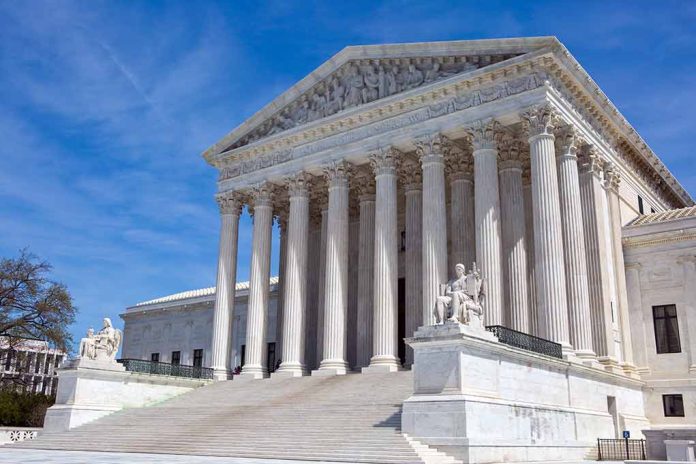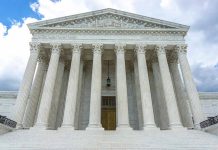
Supreme Court Justice Sonia Sotomayor rejects calls to retire, sparking debate over judicial succession and political timing.
At a Glance
- Justice Sotomayor, 70, faces pressure to retire but remains committed to her role
- Democrats hold a narrow 51-49 Senate majority, complicating potential nominations
- Comparisons drawn to late Justice Ruth Bader Ginsburg’s decision not to retire
- Concerns over future court composition and judicial independence emerge
Sotomayor’s Stance Amidst Retirement Calls
Justice Sonia Sotomayor, the senior-most liberal on the Supreme Court at age 70, has firmly rejected calls to step down from her position. This decision comes in the wake of renewed discussions about judicial succession following President-elect Donald Trump’s victory. Despite pressure from some Democrats and progressive groups, Sotomayor remains steadfast in her commitment to the bench.
The calls for Sotomayor’s retirement echo similar pressures faced by the late Justice Ruth Bader Ginsburg, who chose to remain on the court until her passing in 2020. This decision ultimately allowed then-President Trump to appoint Justice Amy Coney Barrett, further solidifying the court’s conservative majority. The current political landscape, with Democrats holding a narrow 51-49 Senate majority, adds complexity to any potential nomination process.
Justice Sonia Sotomayor Is Expected to Remain on Supreme Court
>> @JessBravin https://t.co/nEfbluhJqk
— Josh Jamerson (@joshjame) November 10, 2024
Political Implications and Senate Dynamics
The delicate balance of power in the Senate plays a crucial role in the ongoing debate. Senator Joe Manchin’s stance on judicial nominations further complicates matters for Democrats. Manchin has stated his unwillingness to support nominees without Republican backing, effectively creating a roadblock for potential liberal appointments.
“Just one Republican. That’s all I’m asking for. Give me something bipartisan. This is my own little filibuster. If they can’t get one Republican, I vote for none. I’ve told [Democrats] that. I said, ‘I’m sick and tired of it, I can’t take it anymore.'” – Joe Manchin
This political reality has led some legal experts to argue that Sotomayor’s retirement at this juncture might be counterproductive. Erwin Chemerinsky, a prominent legal scholar, points out that given the current Senate composition, a Sotomayor retirement could potentially hand Trump another vacancy to fill rather than secure a liberal replacement.
Justice Sonia Sotomayor faces pressure to retire ahead of Trump taking office https://t.co/c6qPEuYUs3
— Allen Mendenhall (@allenmendenhall) November 8, 2024
Judicial Legacy and Court Dynamics
Sotomayor’s role as the first Hispanic and woman of color on the Supreme Court adds weight to discussions about her potential retirement. Her continued presence on the bench is seen by many as crucial for maintaining diverse perspectives in the nation’s highest court. Reports indicate that Sotomayor remains in good health and fully committed to her judicial duties, despite concerns raised about her diabetes.
The Supreme Court’s current 6-3 conservative majority underscores the significance of each justice’s tenure. With public trust in the institution declining, debates about court reform, including proposals for term limits, have gained traction. However, the likelihood of such reforms progressing in the current political climate remains slim.
Looking Ahead: Judicial Appointments and Court Composition
As the debate over Sotomayor’s tenure continues, attention is also turning to other potential changes in the court’s composition. Justices Clarence Thomas and Samuel Alito are nearing retirement age, potentially offering Trump further opportunities to shape the judiciary if he secures a second term. Meanwhile, President Biden has made significant strides in judicial appointments, confirming 213 federal judges to date, approaching Trump’s first-term total of 234.
The ongoing discussion about Justice Sotomayor’s position reflects broader concerns about the future direction of the Supreme Court and its impact on constitutional interpretation. As the political landscape continues to evolve, the balance between judicial independence and strategic succession planning remains a critical issue for both parties and the American public.
Sources:
- Despite pressure on Sotomayor, Supreme Court unlikely to change before Trump takes office. Here’s why.
- US Supreme Court Justice Sotomayor ignores pressure to retire – reports
- Justice Sonia Sotomayor Faces Renewed Calls to Retire After Trump Win














